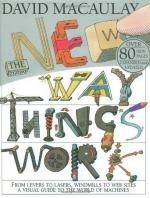
|
| Name: _________________________ | Period: ___________________ |
This test consists of 15 multiple choice questions and 5 short answer questions.
Multiple Choice Questions
1. What happens when visible rays cross the lens of our eye and are bent through the convex surface?
(a) They vibrate the iris.
(b) They form an image on the retina.
(c) They vibrate the retina.
(d) The can burn out the cortex.
2. Where are the pumpkins placed?
(a) In a food processor.
(b) Into a pie.
(c) In a blender.
(d) Into the belly of a transport plane.
3. What type of input uses an analog-digital converter?
(a) Counter-intuitive.
(b) Signal.
(c) Fingertip.
(d) Intuitive.
4. Where can the electromagnetic fields exist that sound waves cannot?
(a) In the brain.
(b) In a vacuum.
(c) Outside of matter.
(d) Through dense matter.
5. What does RADAR use?
(a) Radio waves.
(b) Restored particles.
(c) Recharged particles.
(d) Radiation.
6. If you put a copper wire and a zinc wire into a lemon, what occurs?
(a) A fusing of the copper to the lemon.
(b) A bonding of the zinc to the copper.
(c) A chemical reaction.
(d) A fusing of the zinc to the lemon.
7. In which direction do electrons always travel?
(a) From negative to positive.
(b) From positive to negative.
(c) From true north to magnetic north.
(d) From magnetic north to magnetic south.
8. What makes waves different from molecules?
(a) Only their effects are different.
(b) Waves vibrate, but matter doesn't.
(c) Waves are not actually real.
(d) Waves pass through matter.
9. Why do electromagnets use the forces of attraction and repulsion alternately to keep machines running?
(a) Because electrons are always positively charged.
(b) Because electrons inherently move towards neutrality.
(c) Because an electrical current can only stay polarized.
(d) Because electrical current can be reversed or shut off.
10. What parts of ROM memory can be changed?
(a) The upper chip layers.
(b) None.
(c) The binary code.
(d) The lower chip layers.
11. What are magnetism, heat, and light in relation to an electron's movement?
(a) Elements that hinder an electron's movement.
(b) Elements that enhance an electron's movement.
(c) Elements that an electron's movement can produce.
(d) The mediums through which electrons can pass.
12. To what is the mammoth's presence reduced?
(a) Into numbers.
(b) Into electrons.
(c) Nothing.
(d) Into words.
13. What makes it possible to use light and radio waves to communicate?
(a) They coalesce.
(b) They have short bursts of energy.
(c) They travel in patterns.
(d) They oscillate.
14. What is frequency?
(a) How often a wave is generated.
(b) How often a wave begins moving after encountering a barrier that stops it.
(c) How often one wave moves past a peak of energy.
(d) How quickly a wave moves past each peak of energy.
15. What happens to the charge of an electron in a static electricity situation?
(a) The charge oscillates between negative and neutral.
(b) The charge becomes neutral.
(c) The charge oscillates between positive and neutral.
(d) The charge reverses.
Short Answer Questions
1. What is one type of ray that human eyes cannot perceive?
2. Where does the last mammoth meet Bill?
3. What is white light?
4. For what does Bill think the mammoth will return?
5. What is the absence of any light?
|
This section contains 548 words (approx. 2 pages at 300 words per page) |

|




